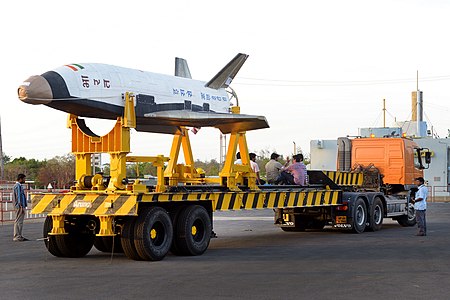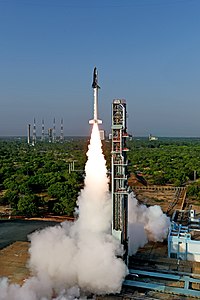RLV Technology Demonstration Programme
Thank you for being part of the Bharatpedia family! 0% transparency: ₹0 raised out of ₹100,000 (0 supporter) |
 Technology Development Vehicle (TDV) for RLV Programme | |
| Program overview | |
|---|---|
| Country | India |
| Organization | ISRO |
| Programme history | |
| Duration | 2016–present |
| First flight | 01:30 UTC, 23 May 2016 [1] |
| Successes | 2 |
| Launch site(s) | |
| Vehicle information | |
| Launch vehicle(s) | RLV-TD |
Reusable Launch Vehicle–Technology Demonstration Programme is a series of technology demonstration missions that has been conceived by the Indian Space Research Organisation (ISRO) as a first step towards realising a Two Stage To Orbit (TSTO) re-usable launch vehicle.[2]
For this purpose, a winged reusable launch vehicle technology demonstrator (RLV-TD) has been configured. The RLV-TD acted as a flying test bed to evaluate various technologies like powered cruise flight, hypersonic flight, and autonomous landing using air-breathing propulsion. Application of these technologies would bring down the launch cost by a factor of 10.[3] This project has no connection with the Avatar spaceplane concept by India's Defence Research and Development Organisation.[4]
History[edit]
In 2006 the Indian Space Research Organisation performed a series of ground tests to demonstrate stable supersonic combustion for nearly 7 seconds with an inlet Mach number of 6.[5]
In March 2010, ISRO conducted the flight testing of its new sounding rocket: Advanced Technology Vehicle (ATV-D01), weighing 3 tonnes at lift-off, a diameter of .56 m (1 ft 10 in), and a length of ~10 m (33 ft).[6] It carried a passive scramjet engine combustor module as a test-bed for demonstration of air-breathing propulsion technology.[7]
In January 2012, ISRO announced that a scaled prototype, called Reusable Launch Vehicle-Technology Demonstrator (RLV-TD), was approved to be built and tested.[8] The aerodynamics characterization on the RLV-TD prototype was done by National Aerospace Laboratories in India. The RLV-TD is in the last stages of construction by a Hyderabad-based private company called CIM Technologies.
By May 2015, engineers at the Vikram Sarabhai Space Centre (VSSC) in Thumba Equatorial Rocket Launching Station were installing thermal tiles on the outer surface of the RLV-TD to protect it against the intense heat during atmospheric reentry.[9] This prototype weighs around 1.5 tonnes and flew to an altitude of 65 km[9] mounted on top of an expendable solid booster HS9.[10][11]
On August 28, 2016, ISRO successfully tested its scramjet engine on second developmental flight of its Advanced Technology Vehicle ATV-D02 from the Satish Dhawan Space Centre for 28 August 2016.[12][13] The scramjet engine will be integrated to the RLV at a later stage of development.[14]
RLV TD Experiments[edit]
Hypersonic Flight Experiment[edit]
The Reusable Launch Vehicle Hypersonic Flight Experiment or RLV HEX was the first test flight in the RLV Technology Demonstration Programme. HEX was successfully conducted on 23 May 2016.[1][15][16] RLV-TD consists of a fuselage (body), a nose cap, double delta wings and twin vertical rudders. It has active control surfaces called Elevons and Rudders.[16] Apart from the twin rudders it is similar in shape and operation to a small Space Shuttle Orbiter. TDV uses 600 or so heat resistant silica tiles and Flexible External Insulation, nose-cap is made out Carbon-Carbon composite with SiC coating. The leading edges of twin rudders are Inconel-718, wing leading edges of 15CDV6.[17][18][19][20][21][22]
HEX was the first test flight of a reusable launch vehicle developed by India. The test flight objectives included:[23]
- Validating the aerodynamic design characteristics during hypersonic flight
- Characterize induced loads during the hypersonic descent through the atmosphere
- Assess the performance of the carbon fibre used in construction of the nose of the vehicle
- Demonstrate first stage separation sequencing
The vehicle was tracked during its flight from ground stations at Sriharikota and a shipborne terminal. The total flight duration from launch to splashdown lasted about 773.6 seconds.[24] The unit was not planned to be recovered.[25][26] ISRO plans to construct an airstrip greater than 4 km long in Sriharikota island in the "near future". Critical technologies such as autonomous navigation, guidance & control, reusable thermal protection system, and descent mission management were validated in this flight.[27]
Landing Experiment[edit]
Reusable Launch Vehicle Landing Experiment was the second test flight in the RLV Technology Demonstration Programme following the Hypersonic Flight Experiment. The demonstration trials will pave the way for the two-stage-to-orbit (TSTO) fully re-usable launch vehicle. LEX was successfully conducted on 2 April 2023 at the Chitradurga Aeronautical Test Range.[28]
LEX was the second test flight of the reusable launch vehicle which was developed by India. The test flight objectives included:[29]
- Simulating the exact conditions of a Space Re-entry vehicle's landing - high speed, unmanned, autonomous, precise landing from the same return path
- Validating the landing parameters such as the ground relative velocity, the sinking rate of landing gears and precise body rates as might experienced by a orbital re-entry space vehicle on its return path
After the successful completion of the mission, S. Somanath, chairman of ISRO, said to the media that they are currently planning to conduct more such landing tests so as to check the readiness of software and hardware under different conditions. The next sequence of experiments which are planned to be conducted after Landing Experiment include Orbital Re-Entry Experiment (OREX) and the Scramjet propulsion experiment (SPEX).[30]
Future[edit]
Two more RLV-TD flights are planned by ISRO: OREX (Orbital Return Flight Experiment) and SPEX (Scramjet Propulsion Experiment).[9][31][32]
Gallery[edit]
See also[edit]
- Avatar, an unrelated spaceplane concept by India's DRDO
- Space Rider a planned robotic spaceplane by ESA
References[edit]
- ↑ 1.0 1.1 "India's First-Ever Indigenous Space Shuttle RLV-TD Launched Successfully".
- ↑ "Indian Space Research Organisation to test its reusable RLV spacecraft". SpaceFlight Insider.
- ↑ "Tuesday, December 22, Isro's small steps towards developing its own reusable rocket [Reusable Launch Vehicle (RLV)] program". LIVE MINT, IN. Retrieved 2015-12-23.
- ↑ "Government of India Department of Space" (PDF). Archived from the original (PDF) on August 5, 2016. Retrieved 2016-04-27.
Feasibility study of project "AVATAR)" has been done by a group of scientists in DRDO. ISRO has no connection with the project.
- ↑ "Welcome to Vikram Sarabhai Space Centre - ISRO_Supersonic Combustion Tech". Retrieved 2015-12-23.
- ↑ ""Space Transportation Systems: What the future beholds" by Dr. B N Suresh". 2 November 2007.
- ↑ "Successful flight testing of advanced sounding rocket - ISRO". www.isro.gov.in. Retrieved 2015-12-06.
- ↑ "ISRO's design of reusable launch vehicle approved".
- ↑ 9.0 9.1 9.2 "Navigation satellite system by March".
- ↑ "Modeling &Control of Launch Vehicles" (PDF). www.sc.iitb.ac.in.
- ↑ "Reusable Launch Vehicles". Brahmand.com. Archived from the original on November 1, 2014. Retrieved 2014-10-22.
- ↑ "Successful Flight Testing of ISRO's Scramjet Engine Technology Demonstrator".
- ↑ "Indian rockets to soon use atmospheric oxygen as fuel".
- ↑ "ISRO set to test scramjet engine". The Hindu. 2015-11-28. ISSN 0971-751X. Retrieved 2015-12-06.
- ↑ India’s Reusable Launch Vehicle-Technology Demonstrator (RLV-TD), Successfully Flight Tested Archived 2021-02-09 at the Wayback Machine. 23 May 2016. ISRO.
- ↑ 16.0 16.1 RLV-TD Archived 2021-04-17 at the Wayback Machine. ISRO. 23 May 2016. Includes diagrams.
- ↑ Kumar, Kiran. ""Indigenous Development of Materials for Space Programme"". Retrieved 30 June 2020.
- ↑ "SILICA TILES AS A THERMAL PROTECTION FOR RLV-TD" (PDF). Retrieved 30 June 2020.
- ↑ "Current Science Volume 114 - Issue 01". Retrieved 30 June 2020.
- ↑ "The technology behind India's Reusable Launch Vehicle". Retrieved 30 June 2020.
- ↑ "A Deep Dive Into ISRO's Reusable Launch Vehicle Technology – Part I". Retrieved 30 June 2020.
- ↑ "A Deep Dive Into ISRO's Reusable Launch Vehicle Technology – Part II". Retrieved 30 June 2020.
- ↑ An Indian space shuttle takes shape 2009
- ↑ Yadav, Sandeep; Jayakumar, M.; Nizin, Aziya; Kesavabrahmaji, K.; Shyam Mohan, N. "Final Phase Flight Performance and Touchdown Time Assessment of TDV in RLV-TD HEX-01 Mission". Journal of the Institution of Engineers (India): Series C. 98 (6): 679–688. Bibcode:2017JIEIC..98..679Y. doi:10.1007/s40032-017-0403-9. ISSN 2250-0553. S2CID 115904439.
- ↑ "India's Reusable Launch Vehicle Successfully Flight Tested". ISRO website. Archived from the original on 14 September 2016. Retrieved 23 May 2016.
- ↑ "ISRO successfully launches Indias first ever indigenous space shuttle". The Economic Times. Retrieved 24 May 2016.
- ↑ "ISRO Gears up for 6 Major Missions This Year". Express News Service.
- ↑ ""ISRO Reusable Launch Vehicles Landing Experiment Successful"".
- ↑ "ISRO successfully conducts the Reusable Launch Vehicle Autonomous Landing Mission (RLV LEX)". Indian Space Research Organisation. isro.gov.in. April 2, 2023. Retrieved April 2, 2023.
- ↑ "Isro reusable launch vehicle's landing experiment successful; RLV closer to orbital re-entry mission". The Times of India. ISSN 0971-8257. Retrieved 2023-04-02.
- ↑ Poster on the RLV-TD
- ↑ "Reusable Launch Vehicle - Technology Demonstration Program (RLV-TD) - ISRO". isro.gov.in.
External links[edit]




